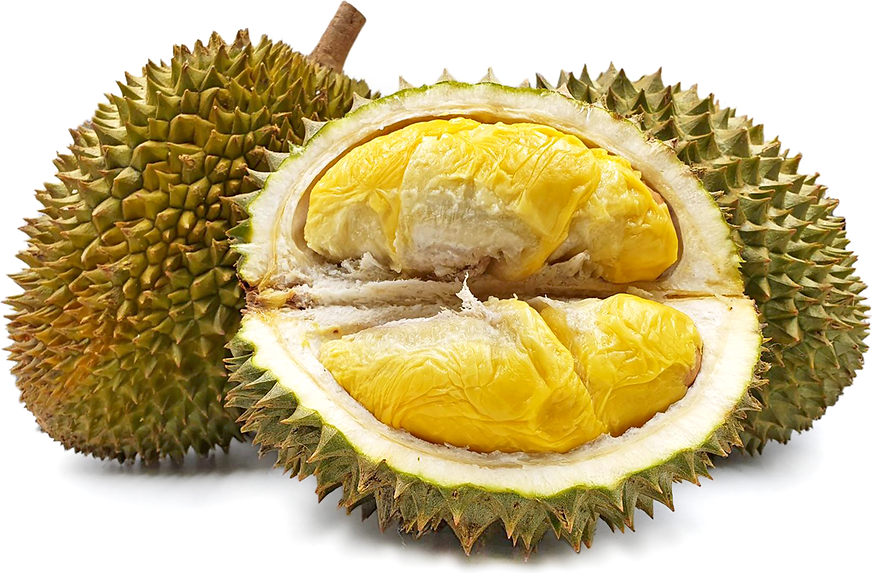


Puang Manee Durian
Estimated Inventory, lb : 0
Description/Taste
Puang Manee durians are a small varietal, averaging 1.3 to 1.8 kilograms in weight, and have an oval, slightly tapered shape, ending at a point on the non-stem end. The fruit’s husk is covered in densely packed, short, pyramidal spines, also known as thorns, and the spines are very sharp. The durian is also primarily dark green, sometimes developing yellow tones with maturity, and has a characteristic brown spot on the pointed end. Underneath the tough exterior, the husk contains a spongy, ivory layer, encasing several chambers of flesh. Each chamber is filled with multiple lobes, also known as arils, and generally includes 1 to 3 lobes comprised of thin skin, a layer of soft flesh, and a large brown seed. The flesh ranges in color from pale yellow to vibrant gold, depending on the maturity of the fruit and time off of the tree. The flesh is also firm when fresh from the tree and softens with time. Puang Manee durians have semi-wrinkled flesh with a sticky, smooth, and dry but creamy consistency. Ripe flesh also sometimes becomes somewhat translucent, showcasing dark spots that are shadows of the seeds embedded into the flesh. The variety is known for its rich, strong sweetness and is said to contain nuances of caramel, almonds, toffee, and butterscotch.
Seasons/Availability
Puang Manee durians are available in Thailand from March through December.
Current Facts
Puang Manee durians, botanically classified as Durio zibethinus, are a Thai variety belonging to the Malvaceae family. The small durians are one of the sweetest varieties cultivated in Thailand and are native to Chanthaburi, where the mother tree is still alive and producing clusters of fruits. Puang Manee durians are favored for their bright golden coloring and rich, sweet flesh. Consumers also prefer the variety for its smaller size, as the entire fruit can be eaten in one sitting. The variety has been around for at least 70 years, but Puang Manee durians did not become popular in Asia until recently, within the last few decades. Puang Manee durians are known as Puangmanee, Phung Manee, Pongmanee, and Puang-Manee in Thailand, Crystal durians in China, and Telu Buaya in Malaysia. The variety is sold domestically throughout Thailand and is also exported to Malaysia, China, and Australia. It has become one of the top three Thai durian varieties sold in China and is traditionally consumed fresh to savor the fruit's flavor, texture, and visual appearance.
Nutritional Value
Puang Manee durians are a source of fiber to regulate the digestive tract and vitamin C to strengthen the immune system while boosting collagen production and reducing inflammation. The fruits also provide potassium to balance fluid levels within the body, manganese to assist with protein digestion, magnesium to regulate blood pressure, and contain lower amounts of phosphorus, iron, copper, and zinc.
Applications
Puang Manee durians have a sweet, rich flavor suited for fresh preparations. The variety’s small size, semi-thin flesh, and very sweet taste lend the durian to eating straight out of hand, and the entire fruit can be consumed in one sitting due to its size. Durian enthusiasts value Puang Manee durians for their butterscotch, toffee-like flavor. The flesh lobes can be picked out of the husk with the fingers and consumed raw, discarding the large seeds. It is important to note that the strong scent of durian will linger on the fingers and some consumers choose to wear protective gloves to prevent the smell from permeating the hands. While uncommon, Puang Manee durians can also be combined into drinks such as smoothies, frozen into popsicles and ice cream, served with sticky rice, or used to flavor desserts. Puang Manee durians pair well with fruits such as mangosteen, watermelon, and coconut, vanilla, and chocolate. Puang Manee durians should be immediately consumed for the best quality and flavor once opened.
Ethnic/Cultural Info
The Puang Manee durian mother tree is still growing and producing fruit on a farm in Chanthaburi, a province in eastern Thailand. Puang Manee durian is named after the current owner, Manee, and Manee’s late husband was gifted the farm by his parents on their wedding day in 1955. The mother tree was already growing on the farm’s property for many years, but one day, Manee’s husband decided to enter the durian into several contests. During one of the contests, a judge came by and asked Manee’s husband what the name of the durian was. At the time, the durian was known as Nuadaeng, translating to mean “red flesh,” but it was also a name tied to a joke among friends. Manee’s husband was too shy to share the current name, so the judge asked what his wife’s name was. Since his wife’s name is Manee, meaning “gem,” the judge recommended the durian be named Puang Manee, meaning “clusters of gems.” This name also describes the durian’s bunched and clustered growing characteristic on the tree. The name stuck, and now the variety is known as Puang Manee worldwide.
Geography/History
Puang Manee durians are native to the province of Chanthaburi, Thailand, and were discovered growing on a farm belonging to a lady named Manee and her late husband. The tree was planted from seed on the farm before the farm was gifted to Manee and her husband in 1955 as a wedding present. The tree produced clusters of small, sweet durians, and the fruits were eventually entered into a contest in the city of Rayong, Thailand. The small durian won first place at the contest and was entered into two more competitions in Sanamluang and Chanthaburi, taking first prize in each. After its success in the competitions, consumers began searching for Puang Manee durians in the markets, further expanding the variety. Over time, Puang Manee durians became a popular variety throughout Thailand and were planted and exported to Malaysia. The variety is also exported to China and Sydney.




